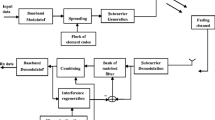Abstract
Spatial diversity is an attractive technology for coping with the fadingchannels encountered in mobile communications.In this paper, the bit error rate (BER) is analyzed theoretically fordiversity reception with a RAKE receiver in aNakagami fading environment using either selection or maximal ratio combining.A coherent binary phase-shiftkeying (CBPSK) direct sequence code division multiple access (DS/CDMA) systemis considered. An arbitrary branchcorrelation is also considered for any diversity order in the case ofidentical fading severity on the branches.
Similar content being viewed by others
References
P. Diaz and R. Agusti, “The Use of Coding and Diversity Combining for Mitigating and Fading Effects in a DS/CDMA System”, IEEE Trans. Veh. Tech., Vol. 47, No. 1, pp. 95–101, 1998.
P. Lombardo, G. Fedele and M. Mohan Rao, “MRC Performance for Binary Signals in Nakagami Fading with General Branch Correlation', IEEE Trans. Commun., Vol. 47, No. 1, pp. 44–52, 1999.
Q.T. Zhang, “Exact Analysis of Post-Detection Combining for DPSK and NFSK Systems over Arbitrarily Correlated Nakagami Channels”, IEEE Trans. Commun., Vol. 46, No. 11, pp. 1459–1467, 1998.
Q.T. Zhang, “Outage Probability in Cellular Mobile Radio Due to Nakagami Signal and Interferences with Arbitrary Parameters”, IEEE Trans. Veh. Tech., Vol. 45, No. 2, pp. 364–372, 1996.
V.A. Aalo, “Performance of Maximal-Ratio Diversity Systems in a Correlated Nakagami-Fading Environment”, IEEE Trans. Commun., Vol. 43, pp. 2360–2369, 1995.
S. Chennakeshu and J.B. Anderson, “Error Rate for Rayleigh Fading Multichannel Reception of MPSK Signals”, IEEE Trans. Commun., Vol. 43, No. 2/3/4, pp. 338–346, 1995.
T. Eng, N. Kong and L.B. Milstein, “Comparison of Diversity Combining Techniques for Rayleigh-Fading Channels”, IEEE Trans. on Commun., Vol. 44, No. 9, pp. 1117–1128, 1996.
M. Schwartz, W.R. Bennett and S. Stein, Communication Systems and Techniques, McGraw-Hill: New York, 1966.
J.G. Proakis, Digital Communications, McGraw-Hill: New York, 1995.
W.C. Jakes, Jr., “Microwave Mobile Communications”, 1974.
E.K. Al-Hussaini and A.M. Al-Bassiouni, “Performance of MRC Diversity Systems for the Detection of Signals with Nakagami Fading”, IEEE Trans. Commun., Vol. COM-33, pp. 1315–1319, 1985.
N.C. Beaulieu and A.A. Abu-Dayya, “Analysis of Equal Gain Diversity on Nakagami Fading Channels”, IEEE Trans. Commun., Vol. 39, pp. 225–234, 1991.
M. Kavehrad and P.J. Mclane, “Performance of Low-Complexity Channel Coding and Diversity for Spread Spectrum in Indoor Wireless Communications”, AT&T Tech. J., Vol. 64, No. 8, pp. 1927–1965, 1985.
Gil-Palaez, “Note on the Inversion Theorem”, Biometrika, Vol. 38, pp. 481–482, 1951.
Erwin Kreyszig, Advanced Engineering Mathematics, John Wiley & Sons, Inc., 1993.
W.C. Lee, Mobile Communications: Design Fundamental, 2nd edn, Wiley: New York, 1993, pp. 202–211.
Author information
Authors and Affiliations
Rights and permissions
About this article
Cite this article
Al-Hussaini, E.K., Sayed, I.M. & Saad, ES.M. Selection and MRC Diversity for a DS/CDMA Mobile Radio System through Nakagami Fading Channel. Wireless Personal Communications 16, 115–133 (2001). https://doi.org/10.1023/A:1026512413471
Issue Date:
DOI: https://doi.org/10.1023/A:1026512413471




